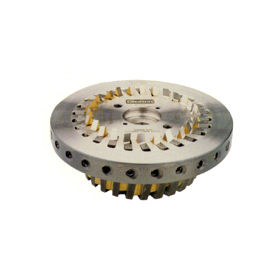GLEASON CUTTING TOOLS AND WORKHOLDING
Bevel Cutting Tools and Workholding
TRI-AC
A blade-type face-breaking system used to complete operations. In drilling, shearing action causes the blades to be cut both on the pressure angle side and on the upper side of the blank side. Due to the negative rake on the discharge side of a conventional blade, excessive tool wear is produced.
The TRI-AC® System solves this problem with a patented bevel angle change on the front of the blade. This modification produces a positive front rake hook on the upper side of the discharge side, thus eliminating the need for a lower cutting blade.
The continuous indexing method requires a second rotary coupling (electronic gear box) between the cutting head rotation and the workpiece rotation. Because of this reason, this method is called three axis process. This is where the TRI-AC name is obtained.
Each blade group of a TRI-AC cutter head has only two blades, one outer blade and one inner blade. As a knife group passes through a slot, the workpiece rotates in the opposite direction of the cutter. This relative movement produces an epicycloidal function across the face width of the work equipment. After leaving the blade group nest, the next blade group enters the next nest. The ratio between the cutting head and the gear should be divided by the number of teeth in the work, the starting number of the cutting head (blade groups). In the production process, roll movement is used as cutting feed. This roll is very slow compared to face milling.
Since the facial pectoral is cut immediately after the tooth in the same roll position, the roller movement can be slower (with the number of teeth of the work gear) and still have the same cutting time as face milling. Of course, Gleason face hobbing is based on single tooth depth. This greatly simplifies the design calculation.

